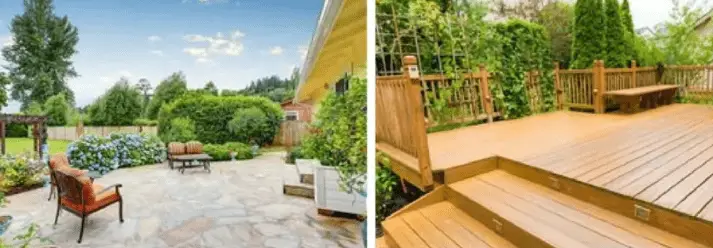Patios and decks are great areas for extending your outdoor living. Although serving the same purpose of outdoor recreation, there are distinct differences between the two. Here is the difference between a patio and a deck, their similarities, installation and maintenance costs.

Patio Meaning
A patio is a paved open or covered area constructed on ground aside or adjoining a home, commonly used for dining, relaxation and recreation. Common materials used for building a patio include concrete, bricks, stone, cobbles and tiles.
Installation and maintenance
Although easier to construct, patios require extensive ground preparation. Before laying pavers on dirt, the area has to be made flat and compact to form a strong support base. You do not require a permit from the local municipality to construct a patio.
Construction of a patio requires significantly less materials and manpower which translates to a lower cost. Averagely, a standard patio cost between $2000 and $4000.
Although subject to weather conditions, patios can last at least 25 years when properly taken good care of. Stone and concrete patios usually last many years without any problem except in area with extreme weather conditions.
Deck Meaning
A deck is a flat surface structure, similar to a floor, but typically constructed outdoors, elevated from the ground with a support structure, and often connected to a building. There is an entrance or a door from the house which you can access a deck through without stepping on the ground.
Installation and maintenance
While it is the best option for sloppy landscapes and uneven yards, construction of a deck is much involving. You may also require a permit from your local municipality because a deck alters the exterior appearance of a home.
A deck can either be roofless or covered and mostly surrounded by a railing. In most homes, wood or timber decking can be part of garden landscaping or an extension of living area. Decks are commonly made from treated lumber, composite materials and aluminum.
Natural wood decking can be expensive to install and maintain. Wood is a natural material that absorb water which makes it to rot when exposed thus not the best choice for humid climates. This can be prevented by constructing a composite decking that is not affected by water or infested by termites.
Building a deck is expensive given the cost of labor and materials are on the higher. Although the cost may vary depending on the type of material, composite cost more than hardwood per unit area. Establishing a deck ranges between $6000 – $22,000.
A deck requires regular maintenance to preserve its aesthetic value and durability. This include cleaning to remove dirt and black water stains. After several years wood requires sanding and refinishing. Wooden deck should be sealed by a protective compound to make it stand up well in elements.
Deck vs Patio – Similarities
- Both can be covered. Covering your patio or a deck is important if you want to enjoy your outdoor living without interference from nuisance bugs, frost, winds and rain. A tent, pergola or retractable screens can be installed over either for privacy and shade.
- Both areas can accommodate fire pits or fire place. You can as well install an electric patio heater for outdoor warmth during cold seasons. To avoid a fire pit burning down your wooden deck, use a fireproof mat or barrier between the fire pit and a deck floor.
- Both structures can accentuate a pool. Composite or hardwood decking, or patio can be installed around a pool to add style and coziness. You can also combine the two areas to offer a statement feature in your backyard.
- Both a patio and deck requires regular maintenance, scratches and cracks need to be fixed. Cleaning has to be done using the right cleaners. This is to prevent or remove mildew, mold, green algae, dirt and stains.
- Both structures can be painted for protection and beauty. Adding a favorite coat of paint on a deck or patio hides imperfections, protect the underlying material and spruce up everything.
- Patios and decks can become slippery when wet thus a slipping hazard. This can happen during cleaning, rains and when situated around a pool. It is important to wipe them dry using a dry piece of towel to avoid accidents and falls.
- Both structures get affected when subjected to extreme weather conditions. Patios experience heaving, sinking or cracking caused by moisture changes in the soil underneath. On the other hand a wooden deck will warp or crack with extreme variation in moisture levels.
- Both decks and patios increase aesthetic and resale value of a home. Homebuyers like homes that come with an additional outdoor living space. The minimum return for a deck is around 70% and 50% for a patio respectively.
We can conclude that a patio is less expensive to install and maintain as compared to wood deck. The two structures share a lot of similarities. Since they both offer outdoor entertainment, the whole decision of whether patio or decking lies with the home owner.